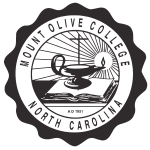University of Mount Olive
|
Official Seal of University of Mount Olive | |
Former names |
Mount Allen Junior College (1951–1956) |
|---|---|
| Motto | Collegium Christianum Pro Homnibus et Mulieribus (Latin)[1] |
Motto in English | A Christian College for Men and Women |
| Type | Private |
| Established | 1951 |
| Affiliation | Original Free Will Baptist[2] |
| Endowment | US$26.29million (2012)[3] |
| President | Dr. Phillip P. Kerstetter |
Academic staff | 650 |
| Undergraduates | 2,500 |
| Location | Mount Olive, North Carolina, USA |
| Campus | Farmland, 250-acre (1.0 km2) Main Campus |
| Colors |
Green and White |
| Athletics |
18 Varsity Teams Conference Carolinas NCAA NCAA Division 2 |
| Nickname | Trojans |
| Website |
www |
 | |
The University of Mount Olive is a private liberal arts college located in Mount Olive, North Carolina. Chartered in 1951, the college is sponsored by the Original Free Will Baptist Convention.[4] The college’s roots and educational philosophy can be traced as early as 1897 when Free Will Baptists in Pitt County, North Carolina, citing a growing need for education in the community, led a discourse on education within the church. These efforts ultimately resulted in the founding of the Ayden Theological Seminary and its successor institution, Eureka College, both in Ayden, North Carolina, to educate ministers and provide a liberal arts education to the local constituency. After a catastrophic fire destroyed the administration building in 1931, Eureka College ceased operations, and the Free Will Baptist church’s efforts to fulfill its educational vision were reinvested in the founding of Mount Olive College.[5][6] In January 2014 the college changed its name to THE University of Mount Olive.
Mount Olive is accredited by the Southern Association of Colleges and Schools, the North Carolina Association of Colleges and Universities, and the North Carolina Department of Public Instruction. A member of the NCAA Division II Conference Carolinas, its sports teams compete as the Mount Olive Trojans.
History
Founding
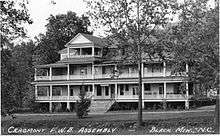
From its inception as a junior college, the University of Mount Olive has been sponsored by the Original Free Will Baptist Convention. The institution was chartered in 1951 and opened in 1952 at Cragmont Assembly, the Free Will Baptist summer retreat grounds near Black Mountain, North Carolina, under the direction of the Reverend Lloyd Vernon. The school was originally called Mount Allen Junior College, taking its name from the mountain near Cragmont.
1953–1970
In September 1953, the college moved to Mount Olive, North Carolina, nearer the center of denominational strength in the eastern section of the state. Under the leadership of the Reverend David W. Hansley, Chairman of the Board of Directors, plans were made to develop a junior college offering programs in arts and sciences and in business. The Reverend W. Burkette Raper was elected president in the summer of 1954, and in September the college began its first collegiate year with an enrollment of twenty-two students.
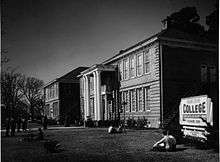
In 1956, the name "Mount Allen Junior College" was changed to "Mount Olive Junior College". In that same year, plans were launched for an enlarged campus which today consists of 250 acres. In September 1970, the college's name was officially changed to "Mount Olive College".
1971–1990
In 1977, the Original Free Will Baptist Convention requested that the Board of Trustees of Mount Olive College work aggressively toward making the college a four-year institution. The 1979 session of the convention endorsed the projected timetable set by the college's Board of Trustees to add the junior year in 1984 and the senior year in 1985.
In 1975, the college began an educational program in Goldsboro, North Carolina at Seymour Johnson Air Force Base.
In 1986, the Commission on Colleges of the Southern Association of Colleges and Schools officially accredited Mount Olive College as a four-year institution to award associate and baccalaureate degrees.
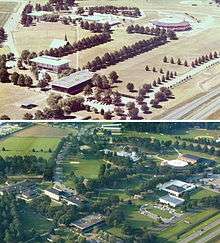
1991–present
Since Mount Olive College's expansion to Seymour Johnson Air Force Base, the college has opened five (5) additional campuses throughout North Carolina: New Bern (1993), Wilmington (1995), Research Triangle Park (1997), Washington (2005), and Jacksonville (2009).
In the fall of 1994, the transfer of all operations to the Mount Olive campus was completed, and the college's original downtown campus was sold.
In January 1995, the Board of Trustees selected J. William Byrd as the third president of Mount Olive College. Dr. Byrd assumed the duties of office on January 31 and was inaugurated on September 30.
In April 2009, the Board of Trustees selected Dr. Philip P. Kerstetter as the fourth president of Mount Olive College. Dr. Kerstetter assumed the duties of office on July 1.
In 2011, Mount Olive College celebrated its 60th anniversary.
In December 2013, Mount Olive College announced an official name change to the University of Mount Olive as of January 1, 2014.
Campus
The University has seven locations in North Carolina, including its main campus.[7] The University's other campuses are located in New Bern, Wilmington, Goldsboro, Research Triangle Park, Washington, and Jacksonville.These additional locations offer associate and bachelor's degree options for adult students through one-night-a-week and online classes. The University also offers several fully online degree programs at the associate, baccalaureate, and master's degree levels.
Major buildings
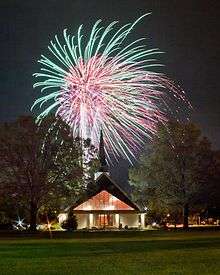
- Rodgers Chapel, located in the center of the campus, serves as the primary facility for the college's religious and cultural activities.
- Communications Building, completed in 2006, is home to the information technology infrastructure and delivery systems that link all of the college's locations together.
- Alumni Cross Walk, completed in 2000, the cross walk was constructed using bricks from the original campus building in downtown Mount Olive. In the center of the cross walk is the Nido and Mariana Qubein Garden House. The garden house shelters the cornerstone and bell from the original campus.
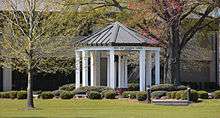 Nido and Mariana Qubein Garden House.
Nido and Mariana Qubein Garden House. - Henderson Hall, completed in 1965, is the oldest building on what is now the main campus. It is home to faculty offices and classroom space.
- Laughinghouse Hall, houses the Department of Fine Arts.
- J. William and Marvis E. "Marcy" Byrd Building, formerly Mount Olive High School until 1965. Houses the Department of Music, Hazel Waters Kornegay Historic Assembly Hall, and Byrd Apartments.
- Moye Library, completed in 1968.
- W. Burkette and Rose M. Raper Hall (Raper Hall), completed in 2006, houses the Tillman School of Business, the Lois G. Britt Agribusiness Center, and the Department of Science and Mathematics. Attached to this building is the Mount Olive Pickle Conference Center and Southern Bank Auditorium.
- Poole Administration Building, houses the offices of the President, Admissions and Financial Aid, the Mount Olive College Press, and Bookstore.
- Waylin Centre, houses the Registrar's Office, the Evening College, and Office of Institutional Advancement.
- Kornegay Arena, contains classrooms for physical education and athletics facilities for the campus and community.
- Lois K. Murphy Regional Center, houses the dining hall, meeting facilities, and recreational facilities for students.
- Pope Wellness Center, is an expansion to the college's athletics and fitness facilities.
Residence halls
Juniors and Seniors can choose to live off campus or in the residence halls designated for upperclassmen, but all freshman and sophomores must live in campus housing. The college's residence facilities can accommodate up to 600 students.

- Annie Mae Whitfield Hall and Everett Edwin Herring Hall, completed in 2009, the complex provides apartment accommodations for mostly upperclassmen.
- College Apartments, housing provided to upperclassmen who meet specified criteria, accommodates 56 residents.
- King-Hart-Griffen Residence Halls Complex, the women's residence halls complex, houses 130 students.
- Grantham Hall, the men's residence hall, houses 126 students.
- The Inn at the University of Mount Olive houses 137 residents and offers housing for males and females.
- J. William and Marvis E. "Marcy" Byrd Apartment Complex, provides accommodations to students in both one- and two-bedroom apartments. Originally built in 1925, the facility is listed under the National Register of Historic Places.
Renovations and expansions
In January 2013, the college launched a capital campaign and announced its plans to raise $20 million over five years for the renovation and expansion of campus facilities. Known as The Campaign for Mount Olive College, the primary objective is to enhance campus facilities in order to better serve future generations of students.[8] The campaign priorities are as follows:[9]
- Enhancing the Henderson Building and residential housing. The modifications to the buildings are expected to cost $8 million and include, efficiency upgrades in accordance with the U.S. Green Building Council's LEED program, making modifications to better meet the needs of students with physical disabilities, enlarging and reconfiguring classrooms, adding faculty offices, increasing the number of available residence hall rooms, purchasing new furniture, and upgrading public spaces to enhance students' social and interactive experiences.
- Expanding Rodgers Chapel. $3 million of the capital campaign will be dedicated to expanding the chapel's classroom and office spaces to support the expansion of the college's religious studies programs. Additionally, the planned changes will increase the number of seats, and private meditation and counseling rooms.
- Create a $3 million cultural arts center in downtown Mount Olive to expand the college's fine arts education program. The center will provide painting and drawing studios, photography labs, classrooms and faculty offices, and exhibit spaces.
- Expanding and preserving athletics programs. Improvements and expansions totaling $3 billion include, the addition of an eight-lane polyurethane track with an artificially surfaced field inside the track, a field house and stadium with seating, scoreboards, locker rooms, a new training room, offices, a public address system and concession stands.
- Making $190 million in landscaping improvements to enhance the campus environment. Modifications include, the addition of seasonal flower beds, new seating areas, special lighting, addition and repair of walkways, and improving landscape drainage.
- Increasing the Annual Fund's financial assistance by $200 million. The financial assistance fund will ensure the continuation of transformational program, address government and grant funding shortfalls, and allow the college to continue to provide full and partial scholarships.
Organization and administration
Mount Olive educates over 4,200 students, making the college one of the fastest-growing liberal arts colleges in the state of North Carolina. The average classroom size is 20 students.
The college is governed by a 24-member Board of Trustees with eight members being elected each year to a three-year term. The Original Free Will Baptist Convention also maintains at least three ad hoc members on the board who each serve three-year terms.
Athletics
The school is a member of the NCAA Division II Conference Carolinas, its sports teams compete as the Mount Olive Trojans. The men's cross country team has won five super-national championships: in 2007, 2008, 2012, 2015, and 2016.
Academics
| University rankings | |
|---|---|
| Baccalaureate | |
| Washington Monthly[10] | 306 [11] |
| Regional | |
| U.S. News & World Report[12] | 51 [13] |
Admissions profile
Fall 2012 applicants:
- Male – 41.14%
- Female – 58.86%
- Students from North Carolina – 83%
- International students – 2%
- Average SAT score – 940
- Average ACT score – 20
- Students receiving financial aid – 90%
Faculty
Mount Olive has a student-faculty ratio of 15:1. 91.6% of full-time faculty members hold terminal degrees.
Library system
Moye Library is named for Reverend and Mrs. J. C. Moye who were active in the Free Will Baptist denomination. In 2006, the library facilities were expanded with the completion of the companion Communications Building. The first floor of the facility houses the reference desk, reference collection, periodicals collection, the Everett Room, the Sawyer Room, and most staff offices. The Circulation Desk is located on the first floor of the main lobby joining the Communications Building and Moye Library.[14]
| Established | 1968 |
|---|---|
| Location | Mount Olive, North Carolina |
| Collection | |
| Size | 100,000+ volumes |
| Access and use | |
| Population served | 4,200 students & 260 faculty |
| Other information | |
| Director | Pamela R. Wood |
| Website | http://www.moc.edu/academics/library |
The library's special collections include:
- The Free Will Baptist Historical Collection,[15] a separate library on the history of the Free Will Baptist denomination
- The College Archives Collection,[16] dedicated to the preservation of materials of and about the college for use by the general public.
- The Jacques Hnizdovsky Collection,[17] a collection of woodcuts by the Ukrainian artist, Jacques Hnizdovsky.
In addition to the facilities and resources provided directly to its student and faculty population, Moye Library has established cooperative agreements with libraries (both academic and public) in the surrounding areas to allow resources subject to their local regulations. Current cooperative agreements have been established with the following institutions:
- Barton College
- CamelCat
- Campbell University
- East Carolina University
- NC Justice Academy
- North Carolina State University
- Old Dominion University
- UNC Coastal Library Consortium
- Wayne Community College
- Wayne County Public Library
Campus life
Student organizations
Mount Olive offers a wide variety of student organizations, including arts and culture organizations, performance groups, sports groups, and religious organizations.
Student media organizations
Mount Olive has two student-run college-recognized media organizations. These media organizations are governed by the Student Government Association (SGA):
- Olive Leaves, a student-produced yearbook
- The Trojan Times, a student-run campus and community newspaper
Student government
A single governing body represents students at Mount Olive:
- Student Government Association (SGA)
Religious life
While Mount Olive is affiliated with the Original Free Will Baptist Church, it has and welcomes students of other faiths and denominations. The college was principally founded on providing an education that allowed students to explore their faith through a liberal arts education.
Songs
Alma mater
The alma mater, written by Daniel W. Fagg, Jr., former academic dean and professor of social sciences, was first published in the college's annual yearbook Olive Leaves in 1958.[18]
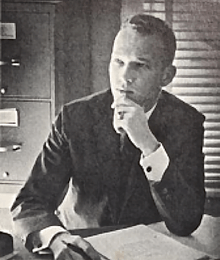
Hail, Mount Olive, Alma Mater,
- endless years shall crown thy head;
- praise we then our great Creator,
- who through all the years shall lead.
May thy torch of truth grow brighter
- still supplied with light divine;
- strong, and clear, and ever burning;
- on the path of wisdom shine.
Alma Mater, Our dear mother,
- honored ever, honored now;
- courage, faith and love devoted,
- be the laurels on thy brow.
O, Mount Olive, how we love thee,
- Dowered with thy fost’ring care;
- kindest heaven smile upon thee,
- God exalt and keep thee fair.[19]
Presidents
- Dr. W. Burkette Raper – First President (1954–1990)
- Dr. J. William Byrd – Second President (1995–2009)
- Dr. Philip P. Kerstetter - Third President (2009–present)
Notable alumni
- Nido Qubein '66 – Motivational speaker and President of High Point University
- Steve Mintz '90 - Professional baseball player
- Tom Layne '07 – Professional baseball player
- Carter Capps '11 – Professional baseball player
References
- ↑ Raper, W. Burkette (2001). A Short History of Mount Olive College. 1. Mount Olive College Press. pp. 36–37.
The college was also designed to be an outreach of the Church in Christian higher education to people of other religious faiths, and to those of no religious faith...In its second catalog (1954-1955) published for the first year of operation in Mount Olive, the College was given a motto, "A Christian College for Men and Women," which was amplified in these words: "The objective of the College is to train and educate young men and women for Christian life and service, thus preparing them for useful vocations and successful living in the home, the church, the school, the community, and the world." ...The founders believed that a Christian liberal arts college would provide the kind of education that was most consistent with a basic belief of Original Free Will Baptists, namely that freedom of the will and the responsibility for making free choices... the founders deliberately avoided establishing a college whose mode of instruction would be indoctrination. They wished to avoid those narrow concepts of dogmatism that might lead Original Free Will Baptists toward becoming a sect or cult...The decision of purpose and philosophy of education was probably the most significant one in the history of Mount Olive College. It would bring the College severe criticism and even hostile opposition from certain persons who either did not understand the basic purpose of education or the historic faith and heritage of Original Free Will Baptists.
- ↑ "History of Mount Olive College". Retrieved 2013-06-07.
- ↑ "Mount Olive College; Regional Colleges (South) #51; US News". U.S.News & World Report LP. Retrieved 2013-09-13.
- ↑ "History of Mount Olive College". Retrieved 2013-06-29.
- ↑ Pelt, Michael, A History of Ayden Seminary and Eureka College, pp. 3–6
- ↑ Pelt, Michael, A History of Ayden Seminary and Eureka College, pp. 17–18
- ↑ "Locations". Retrieved 2013-06-29.
- ↑ "Capital Campaign at Mount Olive College". www.moc.edu. 2013-01-17. Retrieved 30 June 2013.
- ↑ Office of Public Relations for the Office of Institutional Advancement (2013-01-17). "Realizing the Dream, Securing the Future. The Campaign for Mount Olive College" (PDF). www.moc.edu. Retrieved 30 June 2013.
- ↑ "2016 Rankings - National Universities - Bachelors". The Washington Monthly. Retrieved September 6, 2016.
- ↑ Washington Monthly Baccalaureate Colleges 2012. Washingtonmonthly.com. Retrieved on 2013-09-13.
- ↑ "Best Colleges 2017: Regional Universities Rankings". U.S. News & World Report. September 12, 2016.
- ↑ US News & World Report Regional Colleges (South) Rankings. http://colleges.usnews.rankingsandreviews.com. Retrieved on 2013-09-13.
- ↑ "Moye Library - About Us". Mount Olive College. Retrieved 15 September 2013.
- ↑ Mount Olive College. "Free Will Baptist Historical Collection". Retrieved 15 September 2013.
- ↑ Mount Olive College. "College Archives Collection". Retrieved 15 September 2013.
- ↑ Mount Olive College. "The Jacques Hnizdovsky Collection". Retrieved 15 September 2013.
- ↑ Olive Leaves. 1958. Retrieved July 1, 2013.
- ↑ Fagg, Jr., Daniel W. "Origins of Mount Olive Junior College: College Seals and School Songs". Mount Olive College. Retrieved 1 July 2013.
External links
Coordinates: 35°12′30″N 78°04′08″W / 35.2084309°N 78.068759°W
